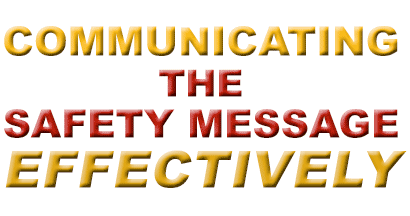Safety Tips for Sweeping Professionals |
Giving Safety Feedback That Motivatesby Thomas E. Boyce, Ph.D.; posted in March, 2013.
However, when used as a primary means of motivating safety, the result is predictable. You get changes in behavior when the rewards are in effect (assuming you are focusing the rewards on behaviors rather than on avoiding injuries), and these improvements are lost when the rewards are removed. So, how do you visibly demonstrate that safety is a value in your organization? You walk the talk by giving safety feedback effectively. With this approach, you will see visible improvements in safety on a day-to-day basis and also in your key safety performance measures (e.g., recordable injury rate). You are also likely to see improved production and a better "bottom line." I also expect you will see improved employee morale. By definition, feedback is information about performance that allows the performer to change his or her behavior. The following are guidelines for providing safety feedback that motivates. 
Focus on observable behaviors rather than on the absence of injuries.When we define safety in terms of behaviors that make an injury less likely (e.g., using appropriate PPE, using the right tool for the job, following procedures, etc.), we identify the potential for injury before it occurs. When behavior feedback corrects an at-risk behavior without criticism, we are practicing prevention. To avoid the blame game, take a situational perspective and avoid labels to describe behavior. Finally, realize that simply correcting without criticism is not enough. Provide positive feedback for safe performance, not just corrective feedback for poor performance.As important as corrective feedback is, we should also provide praise for the safe behaviors observed. When done properly, this form of "social reinforcement" will increase the value of safe behaviors relative to more at-risk ways of accomplishing the same task. Praise should be genuine and specific. Provide feedback right away, and be specific about what was seen.To prevent injuries due to at-risk behavior, corrective feedback must occur immediately to sufficiently reduce exposure to the risk. Likewise, to compete with the immediate comfort, convenience, and time-savings often experienced by the performer of at-risk behavior, positive feedback should be given right away. If this is not practical, then add even more detail. Being specific will help the performer re-live the event, increasing the likelihood that he or she will perform the safe behavior again in similar circumstances. Being specific also demonstrates that you took the time to notice and care about that on which you commented. Provide corrective feedback whenever needed and positive feedback more often.In a reasonably well-functioning safety culture, there should be a lot of safe behaviors observed. Each is an opportunity to increase the value of safety. While it may not be necessary to praise every instance of safe behavior, we should be able to find more things to praise than to correct. So, if you're good at correcting, a ratio of approximately four instances of praise to each item corrected will get you in the ball park of using positive feedback often enough (see the comment above about being genuine). Provide both positive and corrective feedback in private.The old management saying that we should "praise publicly" and "reprimand privately" is NOT good advice. Specifically, BOTH should be done one-on-one and in private. The virtue of doing this with corrective feedback is obvious. And, with positive feedback you can avoid embarrassing the recipient of the feedback in the presence of their peers (which will negate the intended positive impact of the feedback). Moreover, you can avoid others thinking that they were equally as deserving of the praise (which becomes a negative to them even if a positive to the individual recipient of the feedback). Avoid the feedback sandwich – positive and corrective feedback should stand alone.Many managers are taught that, when providing feedback, they should start with a positive to make a person feel good, follow with a corrective to address the real issue, and end with a positive to motivate the person to action. This is called the "feedback sandwich" and should NOT ever be done. It only confuses people, making each type of feedback less effective. Correction or praise can stand alone. Consider that, if you have recently genuinely praised an employee for safe behavior and do so regularly, he or she will be more receptive to the correction without the need to be "buttered up." It is only in cultures where genuine praise is not available that "buttering up" is needed to prevent the defensiveness produced by correction. And, as stated before, even under these circumstances, the "sandwich method" is far from optimal. To resolve conflict, use "and" instead of "but" or "however."We often assert our point of view with the words "but" or "however." By definition, these pivot words negate whatever the other party has said. This will create a platform for defensiveness. Respect people's rights to their opinions by considering that more than one position could be true. To demonstrate this respect, add your point of view by starting with the word "and." It will feel awkward in the beginning and still do wonders to de-escalate conflict. While not an exhaustive list of communication principles, the strategies above will help you to better communicate about the safety performance of others. If you apply these principles regularly, they will become routine. And, the improvements in safety you produce will be readily observed and meaningful. Thomas E. Boyce, Ph.D. is a behavioral strategist, corporate trainer, executive coach and keynote speaker. He is currently president and senior consultant with the Center for Behavioral Safety, LLC. The center is a safety and leadership consulting firm that turns managers into leaders and helps companies create an injury-free workplace. Learn more at www.cbsafety.com or contact Dr. Boyce directly at 775-232-3099 or ted.boyce@cbsafety.com. If you have questions or comments about this article, please contact WorldSweeper.com.
|
© 2005 - 2021 All rights reserved. |
Back to Safety Tips Table of ContentsSite Map / Table of Contents |